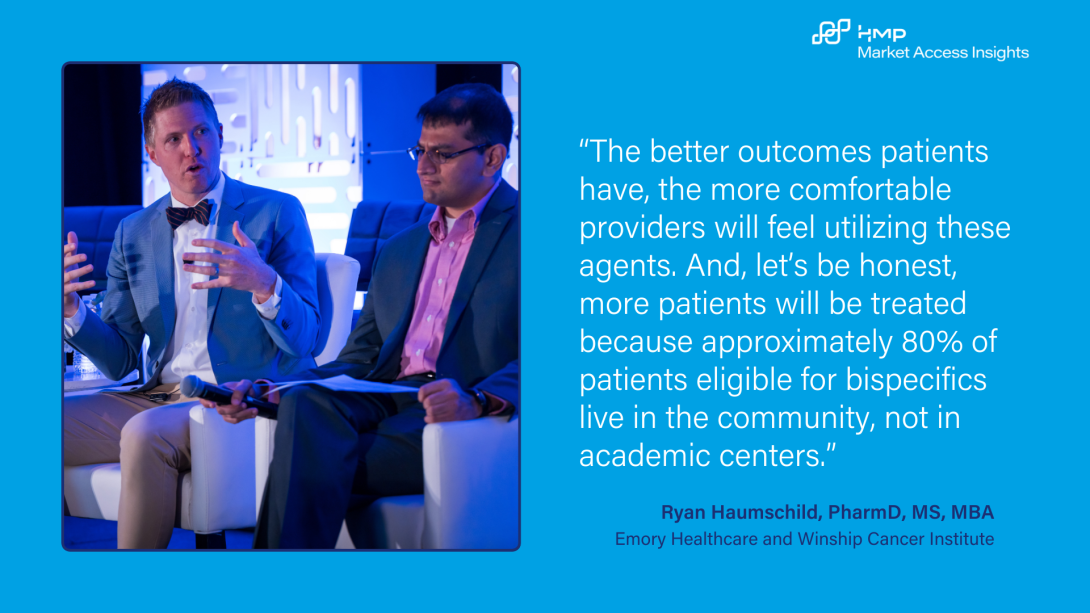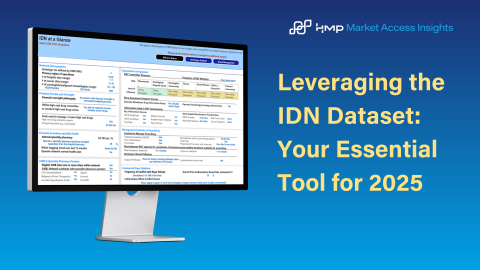

Article
Bispecific Therapies in Community Oncology: Bridging Insights from CPC+CBEx and Beyond
September 26, 2024Authors
Topics
Explore key takeaways from CPC+CBEx on bispecific therapies, highlighting collaboration between hospitals and community practices to expand access and tackle financial challenges.

I'm still coming off the buzz of an exciting week at the Clinical Pathways Congress + Cancer Care Business Exchange (CPC+CBEx), where everything from pathways to emerging therapies took center stage. It was invigorating to engage with the incredible trailblazers leading the charge in elevating the quality and consistency of care patients receive across the US.
The panel session on bispecific therapies featured representatives from the Winship Cancer Institute at Emory Healthcare and The US Oncology Network. Panelists offered a panoramic view of how these innovative treatments are reshaping the landscape and revealed both the promise and the challenges of expanding access to bispecific therapies.
The Bispecific Landscape: CPC Perspectives
The panel highlighted several key points, which align closely with broader trends we've observed in our recent primary research and echo the discussions we heard at the ATOPP Summit we covered earlier this summer.
Adoption Trends
While academic centers are at the forefront of implementing strategies for bispecific therapies, community practices are increasingly exploring their own approaches for identifying opportunities for collaboration with hospitals and academic centers. This is crucial for patient access, as panelists estimate that 80% of patients eligible for bispecific therapies do not live near academic centers.
Though community practices are not as independently advanced in administering these treatments, our recent Community Oncology Trend Report shows that 85% of surveyed sophisticated community practices (we segment this further in our proprietary analysis) are involved in bispecific antibody or chimeric antigen receptor T-cell (CAR-T) treatments, yet only 25% are fully managing these therapies independently.
Hospitals: Keeping the Risk, Sharing the Reward
Hospitals often face significant financial risks, particularly since the costs of these treatments remain consistent, but adverse events like cytokine release syndrome and immune effector cell-associated neurotoxicity syndrome tend to occur early in the treatment process. Hospitals are required to finance the infrastructure to manage these toxicities and are frequently financially penalized for the toxicity-associated hospitalizations. As a result, it’s crucial that these partnerships ensure hospitals are adequately compensated for shouldering a disproportionate share of the risk.
Community Practices: Referring Patients on a One-Way Street
In addition to concerns of the patient burden associated with traveling for care or separating from a patient partway through their treatment journey, community providers may hesitate to collaborate with hospitals offering bispecific treatments due to concerns about losing their patients. Our research has shown that, as integrated delivery networks (IDNs) have grown and implemented internal referral policies, the referral networks of community practices have shrunk, posing a significant challenge to their financial stability. These providers are striving to remain viable and keep their clinics open, which makes the issue of patient retention critical.
For bispecific partnerships to expand and meet the needs of eligible patients, it’s essential that community providers are reassured their patients will return to their care at the appropriate time, and that they will assume responsibility for continuing treatment where feasible.
Driving Collaborative Efforts
The importance of overcoming these challenges and forming collaborations was a recurring theme throughout both CPC and ATOPP. Our research indicates that 60% of surveyed sophisticated community practices have already established partnerships with hospitals to refer patients for bispecific and CAR-T treatments, underscoring the value of such collaborations. In these partnerships, community practices may assume patient management roles following treatment with a CAR-T or after the first several rounds of a bispecific in a hospital setting. These partnerships are a promising development, especially considering that most community practices are unable to provide bispecifics alone and will require a hospital partner to expand access to these treatments.
Future Financial Challenges
Several financial considerations for bispecific treatments are on the horizon. One major question is the impact that value-based care (VBC) arrangements will have on bispecific treatments. While they are currently carved out of programs like the Enhancing Oncology Model, this exclusion is unlikely to last indefinitely. Moreover, how will these VBC arrangements affect partnerships between IDNs and community providers offering bispecific therapies? Who holds the contract in these cases, and how is the upside and downside risk distributed? The complexity of these factors suggests that, at best, such arrangements will be difficult to navigate, and at worst, they could hinder collaboration.
For a deeper exploration into the current and future state of community oncology, our comprehensive 2024 Community Oncology Trend Report is available.
Stay connected with Market Access Insights for more updates from CPC and the latest trends shaping oncology.
The Latest
Article
Thought Leadership Whitepaper: How Will Medicare Drug Price Negotiations Really Impact Providers?
As manufacturers prepare for Medicare drug price negotiations, a critical question emerges: How will your provider engagement strategy evolve when Maximum Fair Prices (MFP) take effect in 2026?
Emma BijesseArticle
Meet Dan: Researcher, Dad, and Oncology Report Innovator
At HMP Market Access Insights, we’re lucky to have a team of experts dedicated to uncovering meaningful insights in the oncology space. One of those experts is Dan, whose work is shaping how we approach community oncology research.
Daniel BuchenbergerArticle
Leveraging the IDN Dataset: Your Essential Tool for 2025
As IDNs face increasing complexity in oncology management, having a strategic approach backed by actionable insights is critical. Our dataset doesn’t just offer data—it equips your teams with the tools to anticipate challenges and seize opportunities.
Emma Bijesse





